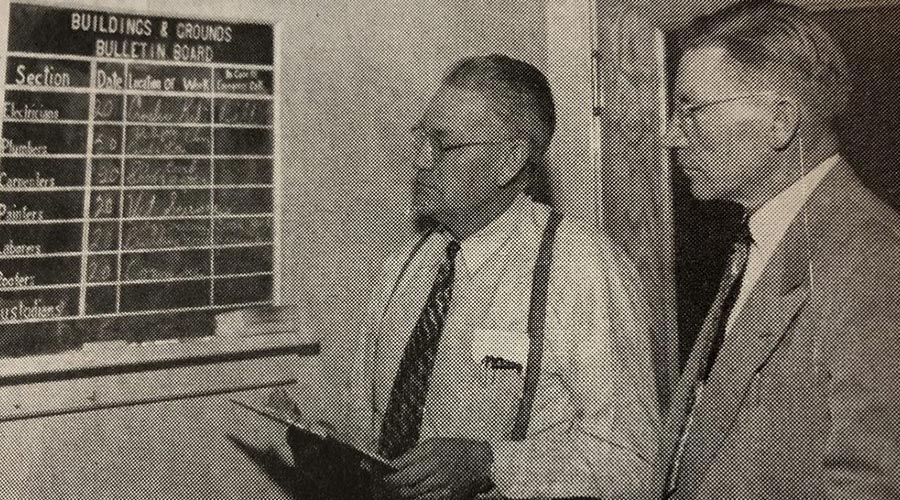Learn How to Use Data and Make Allies
From energy costs per month to occupants per square foot, many facility managers are sitting on a haystack of information and don't know how to find the needles that top management is really looking for.
"We see facility organizations with a lot of data but they don't know how to mine the data," says Friday. "What we hear from senior executives is that reporting capabilities are not very good, and the tendency is to just inundate senior executives with a lot of data that is meaningless." At the opposite extreme, some facility managers don't report anything. Either way, top executives don't have useful metrics to evaluate facility department contributions. A dashboard — a regular report with a handful of key metrics — is a good way to build clout by showing what the department has accomplished.
Becoming skilled in the use of data can bring many benefits. "As trite as it sounds, if you can measure it, you can manage it," says Michael Renfrow, assistant vice president, campus planning and facilities, at the University of West Georgia. A good example is the department's use of lean Six Sigma tools. Lean Six Sigma, a strategy for improving processes and reducing resource use, is data-driven, so Renfrow's department focused on areas where solid numbers were available, like energy use and fuel consumption. Teams, often cross-functional, tracked key metrics, charted trends, identified problems, created action plans, and compared estimated completion dates with actual ones.
The teams found a wide range of opportunities for improvement. The campus community wasn't aware of the cost of the energy they were using, so a website was created to make energy-use information available to everyone on campus. To cut fuel use, employees doubled up when driving to work sites on the same part of campus.
Tight budgets have put some ideas on hold, like requiring new campus vehicles to be dual-fuel, hybrid or electric. But results have been impressive. Average monthly energy consumption fell 12.9 percent even as gross square footage grew 15.4 percent. And gasoline consumption dropped 10.5 percent.
Those efforts are only the latest in a long line of process improvement initiatives that the department has to its credit. "We've been at this since 2001," says Renfrow. During that time, he says, the university has come to look to the department to be a "beacon" to the rest of the campus for best practices.
Win Allies
Facility managers shouldn't underestimate the value of having allies in other departments. To win their support, facility managers may have to go out of their way to learn how they can help other departments. Asking for more work may seem like the last thing a resource-strapped facility organization needs. But in the long run, the more that the facility department is seen as a resource, the more facility managers build clout and the easier life gets to be.
"Once they see your value, you have more people on your side when you're in a staff meeting and you need to contest a budget cut or justify an investment," says Gelderman. "You're not asking for yourself after a while, you're asking for your peer group that you're trying to support."
Being on good terms with other department heads can also reduce one of facility management's biggest headaches: being the last to know about changes that will affect the facility, like a departmental reorganization or plans for servers that will require additional cooling. What's more, facility managers who take care of other departments can call in favors when the time comes.
"One fundamental challenge for FMs is dealing with all the stakeholders," says Kit Tuveson, a former chairman of the International Facility Management Association and a 30-year veteran at Hewlett-Packard, most of it in facility management, before forming his own consulting firm. Those stakeholders may have different expectations, different motivations and different reward structures, but they share one trait: They don't have to listen to the facility manager. The secret, says Tuveson, is to develop "influence without authority" — a phrase that is the title of one of his favorite books.
Influence is built up by a variety of things. One is an understanding of what other people need in a situation, not just what the facility manager needs. Another is the facility manager's track record, not only for hitting deadlines or responding to complaints, but also for dealing fairly and honestly with others.
To Tuveson, it really comes down to credibility. "It's kind of the operating system of human behavior," he says. "If you have it, you can influence people, you can increase your clout. It's earned in many small steps: the way you answer questions, the way you ask for approvals, the way you acknowledge people's successes or help mentor them with recovery from failures. It takes time to build it up, but it can be lost in an instant. You can ask BP about that right now."
While facility managers may not be able to build up credibility, influence or clout overnight, there are times when a single situation can define the department in a lasting way. When the H1N1 outbreak began, there were widespread fears of a deadly pandemic. Texas Children's Hospital in Houston was especially concerned. The state was among those with the most cases, and the hospital feared that its emergency department might be overrun by patients whose parents were worried that their children were infected by the virus.
To help manage the expected patient flow, the hospital created a temporary emergency center in a parking structure. The goal was to identify and isolate suspected cases of H1N1 quickly. The challenge was time. Containing the flu was a top priority, and the new space would need everything from power and cooling to telephones and handwashing stations.
"Many people expected it would take us days," says Bert Gumeringer, director of facilities operations. Instead, the department gave itself a single day to build out the temporary emergency center. One reason the job went so quickly is that the department had reliable allies throughout the organization, he says. "We had always been a department that was focused on customer service, focused on collaboration, and focused on communication. We had a tremendous amount of social capital built up."
The project proved just how strong the department's network was. Gumeringer turned to IT, for example, to fit cable drops for the emergency center into its busy schedule. "That's a laborious process," says Gumeringer. "Because of our relationships, everybody had an attitude of can-do, will-do."
The temporary emergency center was in place for less than two weeks. But the new space did its job, helping the hospital manage an upsurge in patients. And a year later, doctors and nurses are still talking about the project, Gumeringer says. "That tells me the work we did had a tremendous impact on our medical staff and they have not forgotten."
Greg Zimmerman, executive editor, Naomi Millån, associate editor, and Justin Smith, former managing editor, E/Web content development, contributed to this article.
|
Action Items
Routes to Clout
To find real-world examples of tactics that can build clout, the editors spoke to facility managers whose departments received FMXcellence recognition from Building Operating Management in 2010 for adding value to their organizations. The result is a series of audio slide shows — mini-webcasts, really — that highlight five approaches facility managers can use to become more effective, gain more recognition and have more impact across the organization.
Some FMXcellence honorees would say that their efforts earned them credibility or influence, not clout. Regardless of the word, the honorees' work has improved their status in their organizations and provides useful examples for facility managers who want to do the same.
To view the Slide shows, go to: www.facilitiesnet.com/11892bom
Tackling Big Challenges Pays Off With Clout — with Mike Raible, Charlotte-Mecklenburg Schools, and Judie Cooper, Smithsonian Institution
Better Building Performance Boosts FM Standing — with Bob Flowers, Bibb County Schools, and Damon McFall, University of Illinois
Tips of the Trade: Gaining Clout With Communication — with Stan Peterson, Gilbert Public Schools, and Gary Hunt, Bayer Corporation
Networking Helps FMs Get Things Done — with Bert Gumeringer, Texas Children's Hospital, and Kirk Beaudoin, Nike
Building Clout With Data — with Al Tarcola, University of Arizona, and Mike Renfrow, University of West Georgia
|
Related Topics:














